soaked
As you now know the meaning of "soaked", what do you think that the following sentence means? "The weather was really bad, it rained a lot, and I got soaked without my coat."
As you now know the meaning of "soaked", what do you think that the following sentence means? "The weather was really bad, it rained a lot, and I got soaked without my coat."
El cuento “Plaga de dragones” es la adaptación de un cuento de la autora inglesa Edith Nesbit, titulado “The Deliverers of their Country” e incluido en la colección de cuentos The Book of Dragons, ilustrada por H. R. Millar y H. Granville Fell, y publicada en Londres en 1899. La editorial Calleja lo publicó en 1923 en la colección Plaga de dragones, junto con otros cuentos de Nesbit, también adaptados, con ilustraciones de Federico Ribas. El título del cuento también sirve de título a la colección completa.
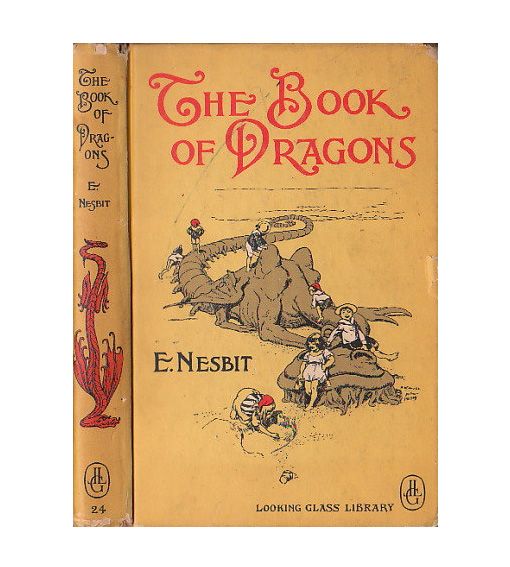
Portada de The Book of Dragons, Looking Glass Library, v. 24, c. 1960.
The English version of this book is a translation from Plaga de Dragones, a story collection which was published by Saturnino Calleja in 1923. This translation was undertaken collaboratively as part of a crowd translation project which took place at the Spanish distance learning university UNED in 2016, involving translation teachers and students. During the translation process, we tried to reach a balance between being faithful to the Spanish text and bringing it into the 21st century for the enjoyment and learning of modern readers. We feel that the stories are still relevant to you these days and trust that you will find the cultural contrast interesting.
The text has been enriched with a number of annotations including audio, term explanations, and various proposals for activities, which are mainly aimed at young non-native English speakers.
El microscopio es una herramienta que se utiliza para observar fenómenos que no se pueden apreciar a simple vista, como las bacterias. ¿Sabías que con algunos microscopios se pueden ver cosas tan minúsculas como los átomos? Pregunta a tu profesor qué más cosas podrías ver con un microscopio. En la época no era un artículo común para tener en una casa. El padre de Eufemia lo tiene porque es doctor.

A contagious illness that causes red spots on the skin and high temperature. Children have it more frequently than adults unless they are vaccinated.
Example: Tommy didn’t go to school when he had measles.

The seed of certain plants which are eaten as a vegetable in stews, soups, salads, or as a side dish.
Example: The smell of the bean stew was delicious.

A person who provides care for somebody else’s children as a paid service.
Example: The nanny told the children a story at bedtime.

According to the Christian tradition, the Three Wise Men, Kings or Magi were distinguished foreigners who visited Jesus after his birth, guided by a star, bearing gifts. They are common figures in Christmas nativity sets, next to the Holy Family and the shepherds.
Example: The names of the Three Wise Men were Melchior, Gaspar and Balthassar.

A chest or piece of furniture for writing with drawers (boxes that slide in and out and are used to hold things). It can have a top that locks with a key and opens upwards.
Example: The old wooden bureau contained old secret documents.

LLacertoidea
Lacertoidea is a group of different lizard species that appeared in the Cretaceous period (145 million years ago - 66 million years ago).
The main features that characterized them are the slender bodies with long tails and four legs ended in five fingers. Also, their skins have overlapped scales with highly varied patterns and colours.

Why do you think that Rosie and Fabian’s mother doesn’t let them open the two drawers? Try and guess the reason!
We are sure that you know what a bureau is and what it is for. Can you name up to five things that you would typically find in the drawers of a bureau and five things that you would never ever find there?
Spain's currency used to be the peseta until 2002, when the euro became the main currency. Do you know how many different value coins and notes are used nowadays in Spain and the eurozone?

Did you know that...
most lizard species are harmless to humans? Only the very largest lizard species can be dangerous.
Lizards are useful for humans because they are the main predators of pest species.
Humans also keep many lizards as pets and some species are even eaten as food.
Listen to the correct pronunciation of the word "lizards":
Sound /z/ is similar to the buzz of bees and wasps. You can also find the same sound in words like "wizard" or "zebra". Are there any words in the same paragraph with the same sound?
Imagine you are a newspaper editor and a lot of dragons are threatening your city. What headline would you choose for your newspaper? What 3 questions would you ask people in the street?

Listen to and practise the pronunciation of the word "shelter":
The sound /sh/ is similar to the sound of skates on ice or when you ask someone to be quiet: "Ssssssh!". You can also find this sound in words like "she", "cash" or "fish".
Do you know where your City Hall is? Do you know what people do in there? Have you ever been inside?
Perhaps you could ask your parents or even the school to organize a visit.
En este cuento, los niños y los adultos tienen comportamientos diferentes. Presta mucha atención a sus palabras y a sus actos, y reflexiona acerca de lo que los diferencia. ¿Qué piensas, por ejemplo, de la actitud del padre de Eufemia? ¿Le interesa más la salud de su hija o del dragón? Fíjate bien en quién es el verdadero héroe de esta historia.
Aunque pueda parecer el ingrediente de una poción mágica, el aceite de castor no tiene origen animal, sino que se refiere al aceite de ricino, que se obtiene de las semillas del arbusto que veis en la fotografía. Desde hace miles de años, el aceite de ricino se ha utilizado con fines medicinales. Por ejemplo, para tratar la irritación de los ojos o para aliviar males de estómago. Ahora se utiliza, sobre todo, en productos de belleza y de cuidado para el cabello. En inglés el ricino se llama “castor-oil plant”. No hace falta ser buen detective para darse cuenta de que el adaptador del cuento ha traducido mal esta frase, que en español no significa nada. Este desliz nos dio una pista para encontrar a la autora original de estos cuentos.

Planta de ricino y botella de Naranjil, marca comercial de aceite de ricino en España.
El padre de Eufemia es doctor, por eso utiliza un vocabulario algo especial cuando describe a la criatura que encuentra en el ojo de su hija. En biología, el apéndice caudal se refiere a la cola de los animales.

Grabado del "Bulletin des sciences" (1791) de la Société philomathique de Paris, con nuestra indicación del apéndice caudal.
¿Recuerdas que el padre de Eufemia es doctor? En biología, los «lacertoideos» o «lacértidos» componen una familia determinada. Si existieran los dragones, ¿a qué familia crees tú que pertenecerían?

Los lacertoideos o lacértidos son los reptiles de cabeza pequeña, vida terrestre y alimentación carnívora. El lagarto y la lagartija pertenecen a los lacertoideos.
Los reales, las pesetas y los duros eran tipos de monedas de uso corriente en España mucho antes de la aparición del Euro en 2002. Un Euro equivale a 166 pesetas. A las monedas de cinco pesetas (es decir, de 3 céntimos de Euro) se las conocía como «duro», y las de veinticinco pesetas (o, lo que es lo mismo, de 15 céntimos de Euro) eran denominadas «reales». Aún hoy siguen utilizándose expresiones que contienen estas palabras antiguas, como cuando decimos que algo «no vale un duro». ¿Qué significa esta expresión? ¿Puedes encontrar y explicar otros dichos similares? Discútelo con tu profesor y con tus compañeros. ¿Sabías que las pesetas empezaron a utilizarse en el año 1868? Tus abuelos o tus padres las usaban cuando eran jóvenes. Pregunta a alguno de ellos qué podían comprarse con cinco pesetas entonces.

Producto utilizado para cuidar el aspecto de zapatos o botas. Sobre todo, del calzado fabricado en piel. Es una crema espesa y oscura, compuesta de diversos materiales, como vaselina o aceite. Se vendía en cajas o botes de diversos diseños y tamaños, y se aplicaba con ayuda de un cepillo, para extender la sustancia sobre la superficie del calzado. Después, se le sacaba brillo con un paño. En los siglos XIX y XX era muy común que, en las calles, ciertas personas desempeñasen el oficio de «limpiabotas».

La grafía «obscuridad» se utilizaba antiguamente para escribir «oscuridad». Otras palabras, como «substancia» se simplifican hoy día también, siendo más común verlo como «sustancia», ya que suele pronunciarse así.
La leyenda de San Jorge narra las aventuras de un caballero armado con una lanza que, valeroso, libra de las fauces de un temible dragón a una princesa que había sido ofrecida a este en sacrificio. Si quieres saber más sobre la leyenda de San Jorge, clica en este enlace, que te conducirá al Libro de los dragones.

Estatua de San Jorge y el dragón (Berlín, Alemania)
¿Cómo crees que vestían los niños y niñas del primer tercio del siglo XX para ir a la escuela? Discútelo con tus compañeros. En el cuento, hay varias pistas sobre la ropa que utilizan Eufemia y Enrique. Fíjate en ellas y apúntalas para responder la pregunta anterior. Si quieres saber cómo era la vestimenta de la época, clica en este link.

Fotograma de La lengua de las mariposas (1999)
En el cuento, el Concejo decide colocar altas columnas «con liga» para controlar la plaga de dragones. Este método se refiere a la caza con liga que, antiguamente, consistía en extender una masa pegajosa de distintos materiales (cardo, frutos de muérdago…) sobre la rama de un árbol para capturar al pájaro que se posara sobre ella. En la actualidad, es un método de caza prohibido por las leyes.

¿Te parece justo para Eufemia y Enrique el final del cuento? Piensa sobre por qué los adultos no agradecen a los niños su hazaña e imagina un final diferente para el cuento. Puedes poner por escrito ese final aquí.
Para controlar la plaga de dragones, el Ayuntamiento quería ofrecer una princesa como recompensa a aquellos que se enfrentaran a las criaturas. ¿Qué piensas sobre eso? Seguro que, a estas alturas, te has percatado de que, en muchísimos cuentos, hay dragones y princesas. ¿Cómo son esas princesas? Compáralas con la protagonista de este cuento y discute con tus compañeros las diferencias. Podéis fijaros, por ejemplo, en historias como la de La Bella Durmiente o como la de Shrek.

Dibujo de la bella durmiente y el príncipe en el cuento de los hermanos Grimm, 1812.
Imagina una tienda en la que se venden los productos anti-dragones que aparecen en el cuento. Aparte del veneno, del jabón anti-dragónico y de las cortinas a prueba de dragones, ¿qué más podríamos encontrar? Describe brevemente un par de artículos o productos. Si quieres, dibújalos. Después, muéstraselo a tus compañeros.

El guardapolvo es una prenda que se coloca sobre la ropa para protegerla de la suciedad. Una bata de científico, por ejemplo, podría considerarse un guardapolvo. También lo son algunas piezas de los uniformes escolares, como los babis, que suelen utilizarse en preescolar.

Detalle del grabado para La moda elegante ilustrada, Cádiz, 1917 (BNE).
¿Qué piensa en secreto Enrique de su hermana y qué le dice en voz alta? ¿Por qué crees que no es sincero? ¿Alguna vez Eufemia le dice a Enrique algo parecido?
Esta frase nos dio otra pista para situar el origen de los cuentos en Inglaterra, pues en España no es habitual que en una ciudad haya muchas iglesias de San Jorge. En Madrid, solo hay una en la calle de Núñez de Balboa, que además es anglicana, mientras que en Londres encontrar la iglesia donde estuviera el santo era un verdadero dilema, ¡pues hay quince! (Hay que apuntar que San Jorge es un santo especialmente admirado en Inglaterra, siendo el patrono de la monarquía inglesa desde el siglo XIV).

“La boda de San Jorge y la princesa Sabra”, 1857, de Dante Gabriel Rossetti.
Aquí, San Jorge se refiere a una expresión o frase que refleja su pensamiento, sus ideales personales. Para él, un hombre solo puede acabar con un dragón, no con varios. Así, su lema sirve como disculpa, ya que es incapaz de acabar con todos los dragones sin ayuda de nadie más.
La espita es un dispositivo que, como un grifo, permite regular la salida de líquidos de un recipiente. Antiguamente, se utilizaba en los barriles de madera o en las vasijas de barro, por ejemplo. En el cuarto de baño «mágico» del cuento su apertura o cierre regula el clima del país de los niños protagonistas. Nos parece interesante que en el cuento aparezca una especie de cuarto de baño en una cueva. Los cuartos de baño tal y como los conocemos ahora eran una gran novedad cuando Edith Nesbit compuso esta historia en 1899. El primer váter moderno lo inventó Thomas William Twyford, un fabricante de cerámica, en 1885. Durante esa época se perfeccionó el sistema de tuberías y alcantarillado de las ciudades y las casas empezaron a tener una habitación especialmente dedicada al aseo.

Interior de cuarto de baño en el catálogo de J.L. Mott, Nueva York, 1888.
Pequeños cuchillos, parecidos a las navajas, que se utilizaban antiguamente para afilar las plumas de escribir o plumieres. Formaban parte del material escolar cotidiano de los niños y de las niñas. Si quieres conocer más elementos de material escolar de principios del siglo XX.
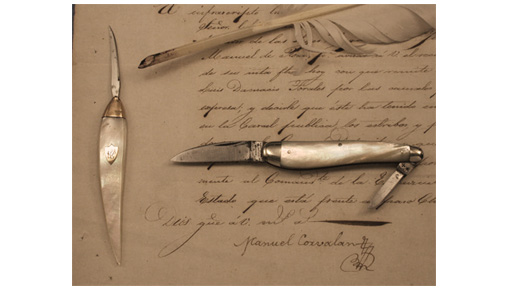
Aquí tienes la ilustración original de la escena en el cuento inglés de Edith Nesbit y la realizada por Federico Ribas para Calleja. Compara el dibujo de los niños en ambas versiones: ¿qué hacen en el dibujo original? ¿Y en el dibujo para la colección Calleja? ¿Qué dibujo crees que refleja mejor las acciones de Eufemia en el cuento?

Al contemplar el reflejo de un espejo mágico tras las espitas, los dos hermanos ven el mundo. Después, contemplan su país con mayor detalle, hasta que llegan a ver su propia casa y a sus padres en ella. ¿Quieres vivir la misma experiencia? Asómate al espejo mágico que hemos preparado para ti.
Los pueblos y ciudades no solo son gobernados por un alcalde o alcaldesa, sino que, en el Ayuntamiento, también trabajan otras personas, que son las que forman el Concejo. A estos empleados se les conoce como «concejales», y se especializan en diversas áreas de gobierno, por lo que existen concejales de cultura, de educación, de sanidad, de medio ambiente y muchos más.
¿Te parece justo para Eufemia y Enrique el final del cuento? Piensa sobre por qué los adultos no agradecen a los niños su hazaña e imagina un final diferente para el cuento. Puedes poner por escrito ese final aquí.
¿Cómo eran los juguetes de tus padres y abuelos? Pregúntales si tuvieron algunos de estos.
Something that is made, sent out, or published.
Example: The man sold all his old issues of comics from when he was a child.

In small groups, think of professions for which people wear something similar to a dust coat. Those who can think of the highest number will win!
Imagine you and your partners are members of the city Council during the plague of dragons in the story. Each one of you must choose a role from the following list and start a discussion:
Rosie and Fabian use a six-sided puzzle to make a castle. Each side contains a beautiful picture. Go to the webpage of a famous museum and select six paintings that you like, each one corresponding to the following famous painters:

A weapon that consists of a knife attached to the front end of a rifle.
Example: Bayonets were used in close fighting long ago.

A heavy sword with one sharp curved edge.
Example: My grandfather has a sabre on the wall from the Mexican war.

Probablemente una de las imágenes del puzle era el famoso cuadro de Murillo "Rebeca y Eliezer", que describe una escena de la Biblia. Abraham le pide a su criado Eliezer que vaya en busca de una esposa para su hijo Isaac. Eliezer encuentra a la bondadosa Rebeca, que le da agua de su cántaro y decide que ella es la escogida.
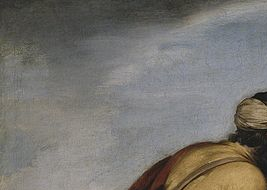
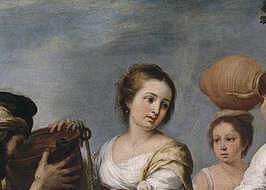
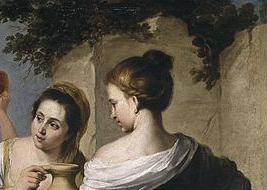
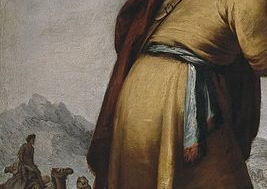
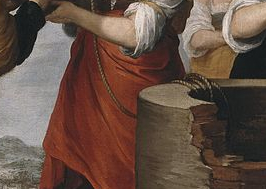

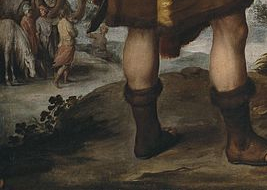
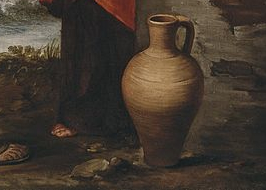
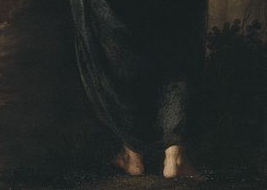
A pointed metal bar for stirring up a fire.
Example: Our father used the fire poker when the grill was about to extinguish.

A plank; a flat, cut piece of wood.
Example: The child fixed small wheels to the board and then jumped on it.

Alquicel: Es una palabra que viene del árabe y se refiere a un tipo de vestidura a modo de capa, que normalmente era blanca y de lana.
Si quieres conocer qué otras palabras son de origen árabe, utiliza el diccionario e investiga: ¿Son de origen árabe estas palabras: “alcohol”, “almohada”, “aleta”, “alcázar”, “alcaldía”, “alhelí” y “altura”?

A grey metal which is very heavy.
Example: That shield is made of lead to protect the doctor against radiation.

The gathering of ripe crops or plants grown on a farm.
Example: Summer is the time of year when the farmers harvest their wheat.

A story from the Bible which narrates how a woman called Rebecca was chosen to be Isaac’s wife by his father’s servant because she was by a particular well and said and did what he was expecting, which he interpreted to be a sign of God.

Two Spanish captains who raised against French Napoleonic occupation and rule, and fought in a famous and decisive battle which took place in Madrid on May 2nd 1808.

Using the memory.
Example: The child learnt the song by heart for the festival.
A famous Spanish legal dictionary written by lawyer Marcelo Martínez Alcubilla in the 19th century.

A long narrative poem by 14th century Italian author Dante Alighieri. It is considered to be one of the greatest works of world literature.

Now that you know the meaning of the verb 'hand over', prepare three sentences of things that people normally hand over at school or at work.
Birdlime is a sticky substance made of different vegetable sources that was used to trap birds long ago. Hunters, etc. used to cover a surface with birdlime and once a bird touched it, it would get stuck to it and not be able to fly anymore.
Birdlime is forbidden in many places. Can you imagine why?
Do you know why Euphemia and Henry are looking for Saint George? Why is he the only who can deal with the dragons?
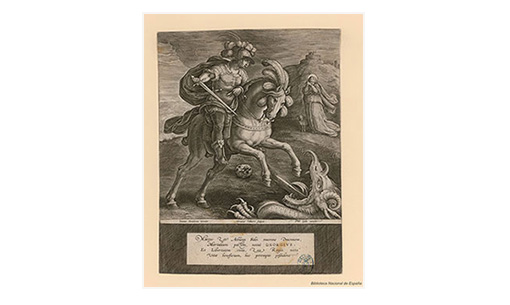
Los escritores utilizan muchos trucos para hacer sus historias interesantes. En este caso, la autora hace que los juguetes y los espacios de juego que construyen los niños cobren vida y se hagan reales dentro de la historia. ¿Conoces otros cuentos en los que ocurra hacen algo parecido?
Aquí tienes un ejemplo muy famoso:

To use up the entire amount of something.
Example: It was such a hot day that we ran out of drinks.

Manuel Rivadeneyra (1805-1872) fue un editor e impresor español que desde 1846 trató de reunir las obras clásicas de la literatura española en una colección que se llamó la Biblioteca de Autores Españoles.

Otro truco para hacer una buena historia es jugar con los narradores y el origen del cuento. Nuestro narrador ha escuchado la historia que acabamos de leer de uno de los personajes del cuento. ¿No es un poco raro? ¿Te fiarías tú de lo que cuente un ratón mecánico?

Inventa una historia con un narrador poco fiable ¡pero divertido!
All of us know what a sword looks like, but what would a special sword need to look like to kill dragons? Would it be big or small? Long or short? Would it have spikes or poison on the blade? Would it be made of forged steel or sterling silver?
Imagine how a sword to kill dragons would be and draw it. You can use colours, pencils or fountain pens to draw it. But the most important thing: don't forget to give your sword a cool name like heroes do!
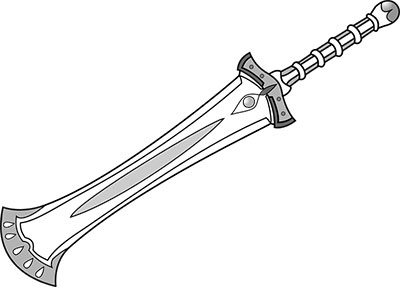
Make a list of places related to the different types of weather mentioned in this paragraph. For example, you can relate Egypt with the sun and England with the rain. Think of other examples from other continents too.
Nowadays, firefighters use fireproof clothes that allow them to work without getting burnt. Do you know which materials are used to make them?
What a messy situation! It looks like a bloody battle is about to start in the middle of Rosie and Fabian’s library! Luckily, the monkey and the mouse are sensible and have an idea to put a stop to all this nonsense.
How would the monkey or the mouse persuade them not to fight? Elaborate a small speech of reconciliation as one of them. First, write it down and then rehearse it orally.

All throughout this story there are two scenarios: a real one in Rosie and Fabian’s library and an imaginary one in a medieval city which is about to become a battlefield… which is inside the library! Where are the children right now: still in the battlefield or back in the library?
A long, loose, outer garment without sleeves that is used as a coat, to protect the wearer from the cold.
Example: The wizard had a purple cloak with stars on it.

North African Muslims.
Example: In the Middle Ages the Moors introduced many new scientific techniques to Spain and the rest of Europe.

A plank with wheels underneath. It can be a skateboard, which is a flat, short, narrow board that has four wheels on the bottom and is used for practising a sport.
Example: It is more fun to stand on your skateboard than to sit on it.

A famous Spanish editor who lived in the 19th century, who published many Spanish works and collections with high quality.

Did you know that there are many countries in the world where some people still live in caves? Can you find examples of some of those places?
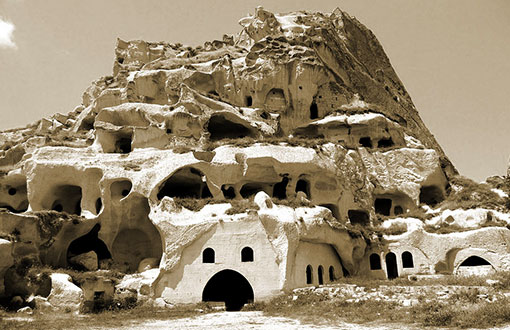
This is the end of the story. Rosie and Fabian are sick in bed. In their feverish sleep, they have a nightmare about being judged in court for having been disobedient and reckless. Distribute the roles at court among the members of your group:
Try to follow the main norms in a real court situation (respect to the magistrates’ indications, turn taking, etc.) and come out with a sentence.
Don’t forget to finish the role play by waking Rosie and Fabian up at the end!

A single example of a type of animal or plant.
Example: This is an unusual specimen of tropical lizard.
The scientific name of a type of lizard.
Example: Lacertoidea have a wide geographical distribution around Europe and Asia.

To leave something in a liquid (often water) to make it very wet.
Example: I soaked my dirty T-shirt in a bowl with hot water and soap.
Tail.
Example: Human ancestors lost their caudal appendixes.
In British English the abbreviation of "Saint" does not have a dot. Thus, the names of saints would be written like this: St Peter, St Paul.
A small piece of dirt.
Example: The officer brushed a speck of dirt off his boots.
A type of vegetable oil that was used as medicine long ago.
Example: Castor oil is good for your skin and you apply it using a cotton ball.

Plural of the word “penny”. The penny is the British unit of currency (money) which is 1/100 of a pound.
Example: There are 100 pence in a pound.

The unit of money in the United Kingdom (symbol £), comparable to the Euro in Spain.
Example: The pencil case cost me 5 pounds.

A small insect-like animal that has a long thin body and many legs.
Example: Centipede bites can be very painful, but they are not generally fatal to humans.

Covered by small, hard pieces (called "scales"), like a fish or a dragon.
Example: The snake’s skin is scaly.
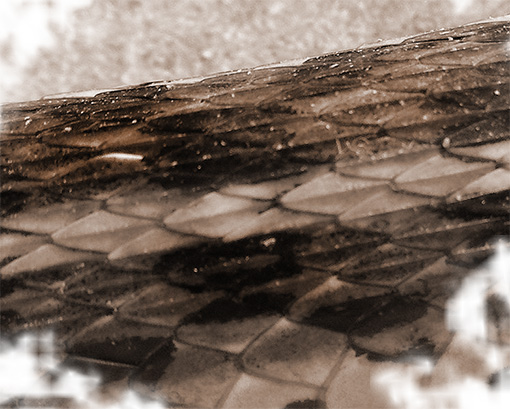
A tiny reptile with four legs, a long body, and tail, usually dark green or brown of colour.
Example: There are over 6,000 species of lizards.

To eat something quickly, without leaving anything.
Example: He polished off the last piece of cake.
The title of the most important article on the first page of a newspaper. The headline is usually printed in large, bold letters in order to catch the attention of the reader.
Example: The headline today is the new baby panda that was born at the local zoo.
To influence somebody or something in a positive or negative way.
Example: Pollution affects the environment.
To go and find a place that gives you protection from the weather or from danger.
Example: She went for shelter because of the heavy rain.
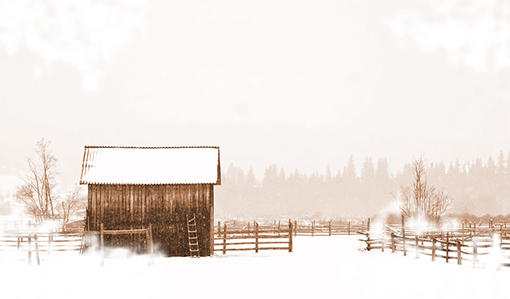
To succeed; to do something that is difficult.
Example: He managed to finish all his homework in one evening.
A narrow opening where the surface has been broken.
For example: There is a crack in the wall and the wind blows through it.

The administration building of the local government.
Example: The mayor holds most of his meetings at the City Hall.

Too many to count.
Example: There are countless stars in the sky.
To give something to someone else.
Example: The security guard at the bank handed over the robber to the police.
A sticky substance used to trap birds.
For example: The hunter trapped a canary with birdlime.
To sit on something. This word is typically used to talk about birds and things that fly.
Example: The birds perched on the telephone wire.

An expression to say that you cannot tolerate something anymore.
Example: That music is too loud, I cannot take it any longer! I need quiet to study.
A liquid or other substance that can kill or harm someone.
Example: The witch put poison in the apple and Snow White ate it.
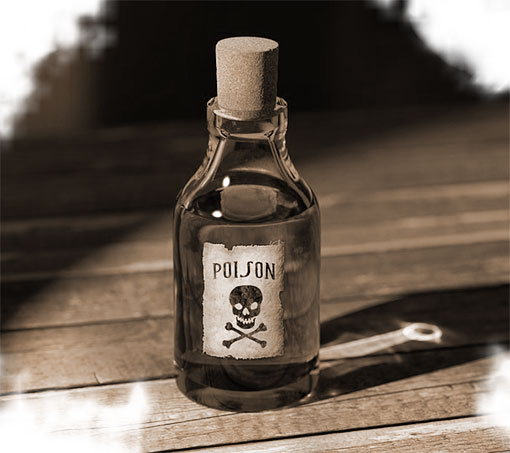
To hit your open hands together; to applaud.
Example: The audience clapped very hard when the show was over to show how much they liked it.

To cut shapes and forms in wood or stone.
Example: The statue was carved from a single block of marble.
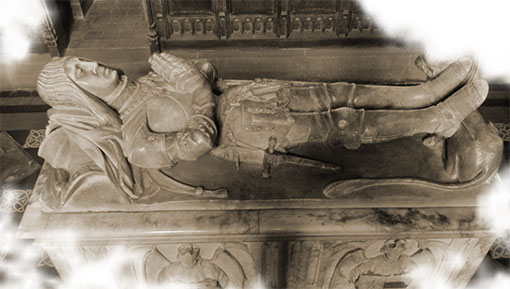
A type of hard white or coloured stone. It often has some irregular lines running through it.
Example: The floors and walls were all made out of different colour marble.

A place (in the ground or in a church) where people are buried when they are dead.
Example: The zombies came out of their graves.

A group of animals travelling together (sheep, goats, birds).
Example: There suddenly was a lot of noise in the air when a flock of birds flew over our heads.

To take something quickly.
Example: The thief grabbed my bag and ran away with it.
A metal object with a valve and a spout at the end of a pipe that allows the manual control of the flow of a liquid.
Example: I forgot to close the tap and now there is water all over the bathroom floor.
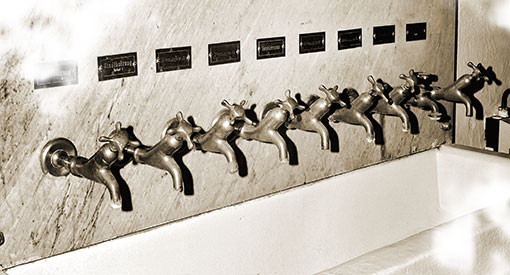
Because of.
Example: The festival was cancelled due to the bad weather.
A long coat that protects clothes from dust.
Example: Carpenters used to wear a dust coat in their workshop to keep their clothes clean from saw dust, glue, and bits of wood.
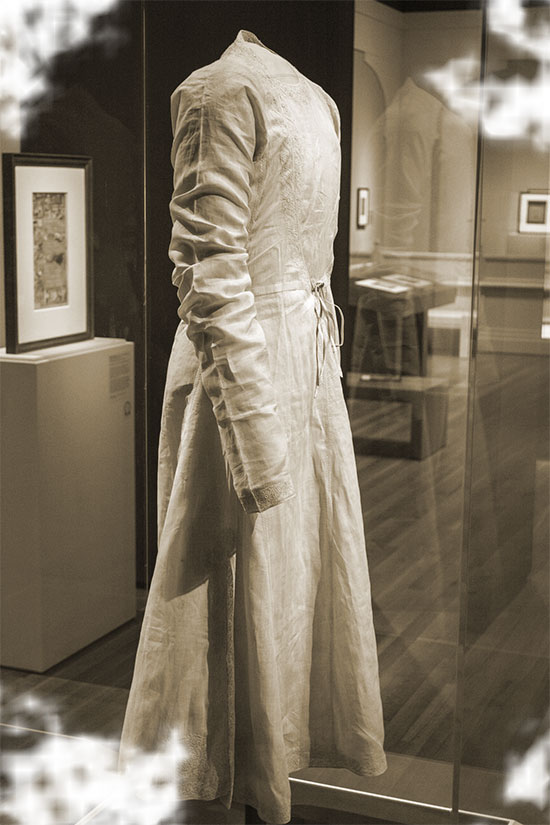
A dark shape where there is no light.
Example: When the sun goes down, the shadows become longer.
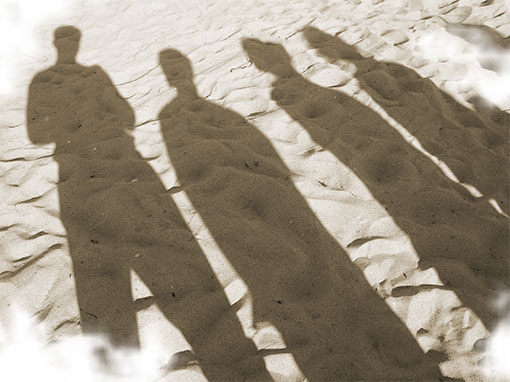
To cover something.
Example: It was very hot and sunny, but luckily we could sit down under a tree, where its shadow fell over the ground.

A dark shape where there is no light.
Example: When the sun goes down, the shadows become longer.

To make a lot of noise when breathing because you are very tired.
Example: Finally, we arrived at the top of the mounting, huffing and puffing and very tired.
To make a lot of noise when breathing because you are very tired.
Example: Finally, we arrived at the top of the mounting, huffing and puffing and very tired.
Very tired; having difficulty breathing.
Example: We walked 20km today. When we got home, we were totally out of breath.
A small knife that you can keep in your pocket to travel. You can open and close it.
Example: The traveller took a penknife out of his pocket, opened it, and cut a piece from the apple he had is his bag.
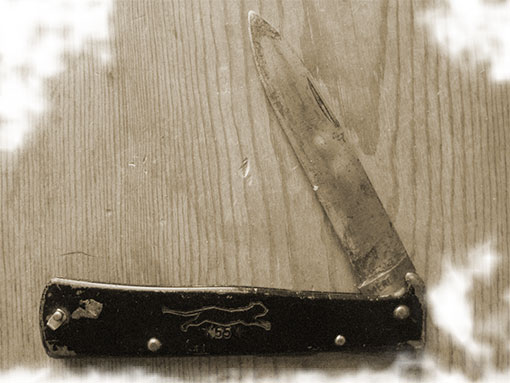
To become free.
Example: The prisoner was able to free himself by breaking the lock of his cell.
The piece of a shirt or t-shirt that covers your arms.
Example: A shirt can have short or long sleeves.
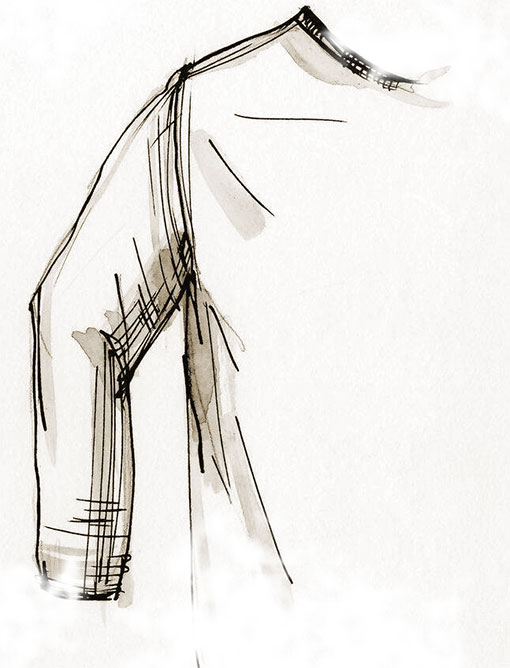
The feeling of being tired.
Example: It was only 8 o'clock in the evening but because of my tiredness I went to sleep early.
To blow smoke and fire out of your mouth.
Example: Everybody knows that dragons can spit fire.
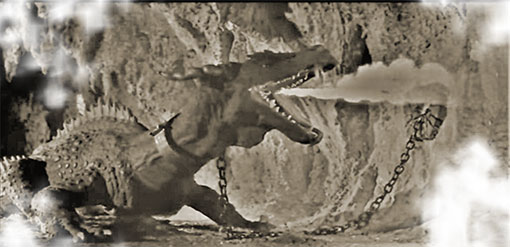
A soft or light wind.
Example: A breeze is nice when it is very hot.
An expression, to eliminate, remove or throw away something not wanted.
Example: I should get rid of some old clothes before buying new ones.
A pipe that usually carries liquids away.
Example: A summer storm filled the drains with rainwater.
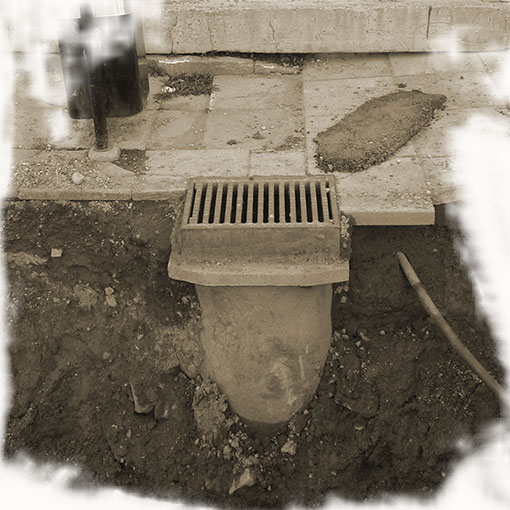
Pick up.
Example: The box was very heavy and they could not lift it.
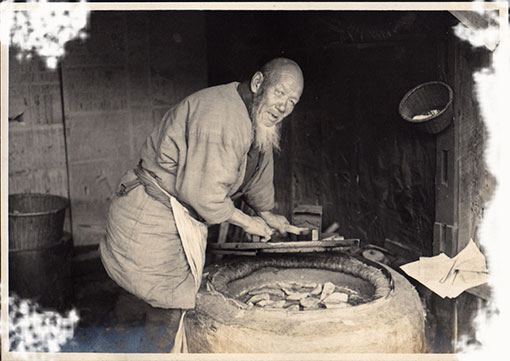
Top, cover.
Example: She filled the jar with honey and closed the lid.

A round opening, an empty space.
Example: There's a hole in my pocket, and all my money fell out.
An expression, not to interfere in someone else's matters.
Not to get involved in something that is not yours; to tell someone to respect our privacy.
Example: Keep your nose out of my diary! It's private.
To involve, to have to do with something or someone.
Example: What I write in my diary does not concern you!
Happy, content.
Example: He was pleased with his grades this term.
Find twelve terms in this word search related to the weather that you learnt while reading this story. Place your cursor on the first letter of each word and then click and drag it all the way to the last letter:
Listen to the children's father telling them off for being mischievous. How does it compare with the way a Spanish father would have said it? Now try to tell off somebody in English using a similar intonation pattern to the one in the story.
The children in the story managed to get rid of the dragons very cleverly. But... what happened with the dragons after they fell through the drain hole? Can you imagine where they went?
Write a brief description of this place that you have just imagined. Think about where it is, the materials it is made of, if it is bright or dark and scary, and if there are other living beings apart from dragons.
As you now know the meaning of "soaked", what do you think that the following sentence means?
"The weather was really bad, it rained a lot, and I got soaked without my coat."
Lacertoidea is a group of different lizard species that appeared in the Cretaceous period (145 million years ago - 66 million years ago).
The main features that characterized them are the slender bodies with long tails and four legs ended in five fingers. Also, their skins have overlapped scales with highly varied patterns and colours.

It would be more common to say “caudal appendage” than “caudal appendix”. Both terms belong to the same lexical family. However, nowadays “appendage” generally refers to an external element that projects from the body, while “appendix” refers to something attached to something else.
Now that you understand what a "long caudal appendix" is, write the names of three animals that have got one.
Which of the following carriages would be useful for carrying the dragons?

Why? Why not?